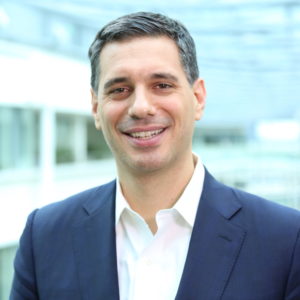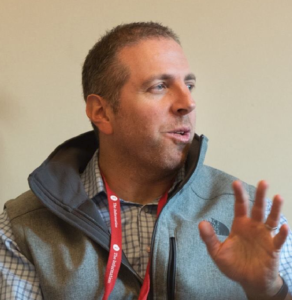Conversations with heads of digital at Bayer, GSK, Novartis, Sanofi, and Johnson & Johnson
How would you build a pharma company from scratch five years from now? That’s the question Novartis chief digital officer Bertrand Bodson asks himself. “What would be different, from talent to drug discovery to commercialization?” This is the role of the chief digital officer in a 21st-century pharma organization.
This new C-suite title first came into vogue in the early aughts. But when Takeda named Bruno Villetelle its first chief digital officer in 2014, and Bayer did the same that year with Jessica Federer, pharma signaled it was finally reckoning with a new world order — it could either change with it or be left behind. In 2016, Saskia Steinacker took on the role of global head of digital transformation at Bayer. In the same year, Marc Leibowitz joined Johnson & Johnson as global head of health technology and digital health.
In early 2017, GlaxoSmithKline made waves when its consumer health unit hired Marc Speichert as chief digital officer. With a career that included time at L’Oréal and Google, Speichert was the definition of “an outside hire.”
Then the avalanche came. Heather Bell took on the role of SVP, global head of digital and analytics at Sanofi in February 2017, Bodson was named chief digital officer of Novartis in January 2018, and Jim Scholefield left Nike to become chief information and digital officer at Merck in November 2018.
And at the beginning of this year, Lidia Fonseca began her role as chief digital officer of Pfizer. (At press time, Sanofi had appointed Ameet Nathwani as chief digital officer, in addition to his current role of EVP, chief medical officer.)
Gone are the days of the internet kids convincing pharma to tweet. Today’s chief digital officers are charged with digital transformation across the entire value chain. They come to the table with deep management experience from a breadth of industries, including beauty, retail, apparel, big tech, startups, and yes, pharma. Why now? They are motivated by the opportunity to work on something meaningful (health) in a new way (digital), and in a big way (at scale).
Marc Speichert
Global chief digital officer, GSK Consumer Healthcare

Having built a career at Colgate-Palmolive and L’Oréal, it was during his time at Google that Swiss-born Marc Speichert found GSK. When he heard the pharma company was hiring a chief digital officer, he jumped on the opportunity. “When I was at L’Oréal, we talked about how beauty and digital are a perfect match. Health and digital are an even better match,” he says. “We deliver on our mission as a company to do more, feel better, and live longer.”
Speichert describes his career as “very anchored in marketing,” yet exhibits passion to support a more digital mindset across the firm. And he is not alone: In 2017, Karenann Terrell, formerly of Walmart, joined GSK as chief digital and tech officer to improve the use of new tech across the group.
Speichert embraces and drives new ways of working at GSK, including the development of an advisory board whose purpose is to “push us harder on the boldness of our thinking.” He specifically seeks individuals from other industries who have a completely different perspective. Another program pairs GSK leaders from multiple disciplines with peers outside their industry. For example, an HR exec might be paired with a peer from the tech industry. “This is great because it challenges my thinking,” says Speichert.
One of his proudest achievements is developing the infrastructure that allows GSK to flex digital muscle while creating efficiencies. His team looked at a number of disparate functions, from finance to marketing, and remixed to form an end-to-end team, from early insight to the actual innovation. GSK was also the first health company to directly partner with Google on its tech stack.
With the right infrastructure in place, the company can bring campaign ideas to life in a fresh way. While Speichert notes consumer healthcare is not perceived as bleeding edge, “we have shown it can be creative and breakthrough.” From a cultural perspective, he seeks to infuse courage, bravery, and boldness in how GSK does things, and at a new pace. As pharma moves from a product to a platform focus, the highly strategic approach requires a focus on new infrastructure and services to meet the needs of customers in new ways. Ultimately, Speichert notes, “digital is all about execution and the devil is in the details.”
The approach has paid off — the Gartner L2 Digital IQ Index shows GSK as competitive with top personal care brands such as Unilever and Procter & Gamble.
Bertrand Bodson
Chief digital officer, Novartis

Also in the “outsider” category is Bertrand Bodson, chief digital officer at Novartis. Bodson’s career includes time at Boston Consulting Group, Amazon, Sainsbury’s, EMI Music, and a startup he cofounded and sold. Two things drew Bodson, a Belgian citizen who’s lived and worked in Europe and the U.S., to his current role: the sense of purpose and the opportunity to have impact at scale. Whereas many pharma companies have tiptoed into digital, Bodson has executive commitment and a 10-year investment. His work extends across R&D, drug development, commercial, technical, and new business models. “I like that canvas,” he says.
He sees Novartis as the largest startup on the planet, noting life sciences companies run thousands of experiments before arriving at a potentially viable compound. And yet “it still takes 12 years, $2.5 billion, and a decreasing return on capital expended to bring a drug to market,” notes Bodson, who alludes to a future where developing medicine is a computational exercise and engagement happens on patients’ own terms.
Initially, Bodson thought the role would require more change management to empower curiosity, learning, and entrepreneurial thinking among 120,000 employees. “I didn’t know how big the appetite would be,” he explains. It turns out many people wanted to join what he calls “the digital army.” Bodson is rapidly building a team of 1,500 people across numerous functions and going long on partnerships.
For Bodson, effecting change hinges on establishing concrete programs and projects, such as a collaboration with Data42 to bring all of Novartis’ data sets together in hopes of new discovery. “We have been sitting on over 20 years of patient trial data, comprising about 2 million patient years, but we have never mined that data vertically,” he says. He wonders what new insights this data set might yield, from a more efficient drug combination to novel population subsets. On the commercial side, Novartis recently announced the launch of an AI assistant to better prepare reps, serving up the right assets at the right time.
Digital therapeutics are also on his list. When Novartis-owned Sandoz and Pear Therapeutics launched reSET for treatment of patients with substance use disorder, each party brought its strengths to the table. The startup drove an aggressive timeline. Sandoz brought the expertise in commercialization, patient support, and reimbursement. In this new world, partnerships are key. “That is why we opened Biome,” says Bodson of the newly launched digital innovation lab.
Heather Bell
SVP, global head of digital and analytics, Sanofi

Following nearly a decade with McKinsey & Co. and another four years leading international strategy at the University of Oxford, it was the opportunity to work with “really smart people trying to solve really hard problems” that prompted Montreal-born Heather Bell’s leap to pharma. She finds Sanofi’s achievements developing vaccines, insulin, antihistamines, and a rare disease model highly motivating.
Sanofi has outlined seven digital priorities representing the entire value chain: digital clinical trials; the factory of the future; multichannel physician engagement; consumer precision marketing and e-commerce; real-world analytics; drugs plus solutions; and integrated diabetes care.
In addition to leading two specific priorities, Bell is responsible for ensuring global alignment and collaboration across all initiatives. Clinical trial innovation requires partnership between a team of digital disruptors and colleagues in clinical operations around the globe. “It’s one thing to do this in the U.S. and another around the world,” says Bell, who adds online trial recruitment is now available in 16 countries.
Bell’s work also requires external collaboration. Onduo, Sanofi’s joint venture with Verily, aims to be a virtual diabetes clinic, bringing together therapeutics, devices, exercise plans, coaches, and endocrinologists to support people living with diabetes. The product has been launched in the U.S. with a limited number of payers, with the long-range goal of driving profit from an integrated solution.
Moving mountains starts with people, and Bell is quick to note Sanofi has recruited talent from General Electric, Procter & Gamble, and Amazon. To equip the broader team to operate in this new universe, Sanofi builds out capabilities in advance through digital bootcamps. Bell responds to a range of reactions — from “I am so fired up, sign me up” to “help me understand why this matters” — but for the most part, colleagues are neutral and optimistic.
Success also hinges on understanding behaviors and motivations of stakeholders, from patients to physicians to the people on the factory floor, and this is part of the premise of the drugs plus team. “Tech alone is never the answer,” Bell says.
Saskia Steinacker
Global head of digital transformation, Bayer

Saskia Steinacker’s career in life sciences began on the marketing side at Bayer’s Leverkusen, Germany, offices. Now, in addition to leading a transformation team of 10, she heads Bayer’s digital excellence council, which includes representatives from the pharmaceutical, consumer health, and crop science divisions, relevant corporate functions, and country organizations. She is also an appointed member of the EU High-Level Expert Group on Artificial Intelligence.
Steinacker doesn’t see digital as a noun. Nor is it relegated to marketing. “We are past that first stage,” she says. Rather than focusing on the tech, she proposes starting with customer needs. “Digital is a means to the end. It’s capturing the entire value chain,” which for her means considering a world where we identify disease at an earlier stage and bring better solutions to market faster. “We can use digital solutions to create added value for our patients and customers beyond the product or existing business model.”
Through the digital excellence council, Bayer seeks to digitize customer experiences, digitize operations — from supply chain management to recruiting — and drive new business models. Steinacker brings cross-unit and cross-border collaboration — in real time — from Bayer’s respective business units. To effect change across the organization, Bayer strives to “develop an attitude about work and thinking that more closely resembles the culture of startups: approaches such as design thinking, trial and error, and rapid prototyping,” says Steinacker.
Bayer offers training programs to help employees ramp up on topics such as AI or blockchain, masterclasses for more experienced employees, and a reverse-mentoring program for managers to learn new tech from digital-native employees.
Partnerships are also part of Bayer’s new way of working. Globally, its G4A programs create opportunities to engage more deeply with startups. For example, Budapest-based AI startup Turbine has collaborated with Bayer since 2016.
Marc Leibowitz
Global head of health technology and digital health, Johnson & Johnson

Prior to joining Johnson & Johnson, Marc Leibowitz spent nearly two decades in tech, both as an entrepreneur and inside organizations such as StumbleUpon, Dropbox, and Google. He made the switch to healthcare to “make the world a better place,” which he adds “is the sort of audacious ambition that’s motivated me throughout my career.”
He is motivated by the opportunity digital presents to help people be well. This includes avoiding getting sick in the first place, or perhaps better managing a chronic condition. “The incumbent regulations, incentives, and reimbursement infrastructure are much less robust in wellcare, which allow for more experimentation and innovation,” says Leibowitz.
He leads J&J’s digital transformation agenda, health tech strategy, and go-to-market activities — spanning programs, products, partnerships, investments, acquisitions, and joint ventures — across the organization’s three worldwide business units: consumer, pharma, and device. “My responsibilities include partnering with commercial and R&D leaders to transform how health and wellcare is delivered, managed, and experienced, as well as exploring ‘white space’ opportunities to blend science and tech in ways that have potential to impact human health and wellness at scale,” he explains.
“Digital at J&J is about embracing a user needs-centered mindset and an iterative, data-driven approach to prioritization and problem-solving so we can accelerate the velocity at which we bring life-enhancing, if not life-saving, solutions to the world.”
And yet Leibowitz also senses an urgency for the company, and pharma at large, to adapt to the digital age, which includes hiring talent from the outside, giving them the runway to experiment, and learning a new way to work. This is highly strategic and touches every aspect of the business. He notes it requires “critically assessing established methodology around decision-making, funding, hiring, space-planning, goal-setting, and compensation, and asking how these processes can be made more user-centric and efficient. From a strategic standpoint, I’m always thinking about how we can operationalize ideas and bring them to life.”
The Lab Report helps executives make sense of emerging trends and new opportunities. Sign up for the newsletter, and we’ll send insights straight to your inbox.
This article was republished with permission from the March 2019 issue of MM&M.


